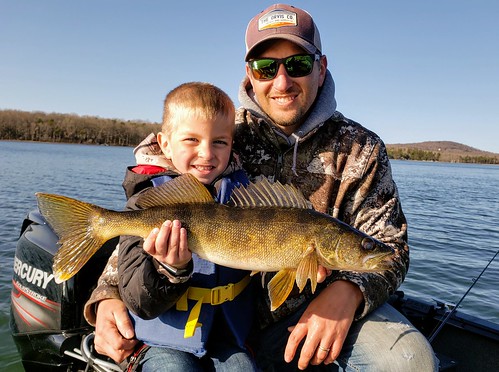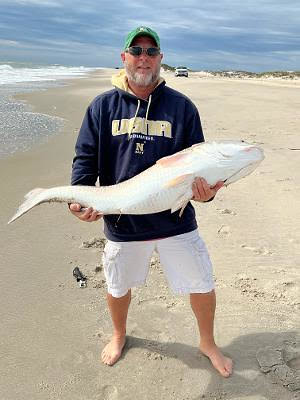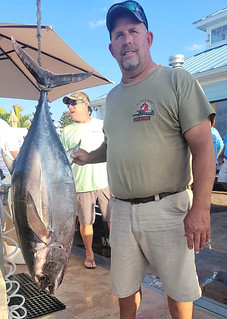
Maryland Fishing Report – September 28
As we reach the end of September, anglers are seeing some exciting fishing action – cooling water temperatures are transitioning some marine fisheries and spurring freshwater fish to feed more aggressively.
The end of summer brought some excitement to the Atlantic Coast. Two new state record fish were caught out of Ocean City – a 339-pound swordfish was caught by Jeff Jacobs and a 77- pound albacore by Thomas “Tad” Bodmer.
Forecast Summary: September 28 – October 4:
Weather conditions this week will be driven by the remnants of Hurricane Ian. Cool temperatures will prevail all week with rains likely Friday through Tuesday, the heaviest rain reaching us on Friday and Saturday. Winds of 10 knots to 20 knots are expected with gusts higher through Tuesday. Chesapeake Bay surface water temperatures have dropped to the low 70s and are expected to drop all week. Maryland rivers are currently running in the mid 60s to upper 50s.
With cooling air temperatures and stronger winds, most of the main Bay areas have oxygen to the bottom. At the following locations, adequate oxygen conditions can be found from the surface down to these depth ranges: from the Virginia state line up to the Gooses Reef buoy, surface to bottom; Little Choptank up to the Choptank River, surface to bottom; Bloody Point, 35 feet; Bay Bridge, 30 feet; Swan Point, 30 feet; and Still Pond to Susquehanna Flats, surface to bottom. Good oxygen conditions are present in most Maryland rivers, including the Potomac, from surface to bottom. With cooling water temperatures, gamefish will begin to range more vertically in the water column to find adequate oxygen and their preferred water temperatures and food.
Expect above average flows after Friday for most Maryland rivers and streams. There will be above average tidal currents through Saturday due to the previous September 26 new moon.
Expect poor water clarity for Maryland portions of the Bay and rivers beginning this weekend due to increased flows from Ian. To see the latest water clarity conditions, check Eyes on the Bay Satellite Maps on the Maryland Department of Natural Resources website.
As always, best fishing areas could be further refined by intersecting them with underwater points, hard bottom, drop-offs, and large schools of baitfish.
For more detailed and up-to-date fishing conditions in your area of the Bay, be sure to check out Eyes on the Bay’s Click Before You Cast.
Anglers at the Conowingo Dam pool and at the edges of the Susquehanna Flats are seeing a slight improvement in striped bass fishing. The best tactics are casting poppers, crankbaits, and paddletails during the early morning hours. The mouths of the tidal rivers in the upper Bay are providing even better striped bass action for those casting along shoreline structure, points, and the edges of grass beds.
The most popular ways to fish for striped bass in the upper Bay remain live-lining a mix of spot, eels, or white perch, or drifting fresh cut bait or peeler crab. The fish are still holding in the Pooles Island area, the Tolchester Lumps, the mouth of the Patapsco, Swan Point, and the Love Point rocks.
Jigging at the Love Point rocks and the Key Bridge can be an alternative and with cooler water temperatures, jigging for striped bass is improving. Striped bass and small bluefish can be found feeding on small menhaden and bay anchovies and their locations are given away by diving seagulls, slicks, or marks on a depth finder. The edges of the major channels are always a good place to look for schools of bay anchovies or small menhaden being swept by strong currents.
Trolling for striped bass is also becoming more viable as the water temperatures cool and fish are being found along channel edges. Umbrella rigs pulled behind inline weights with bucktails dressed with sassy shads or twistertails as trailers are popular.
Catfish is a dominant species in the upper Bay and the tidal rivers, and fishing for them is an excellent way for anglers looking to extend their fishing day and fill their freezers. Any kind of fresh cut bait, chicken liver, or a variety of scented baits will work for all three species of catfish found in the upper Bay. Flathead catfish can be found in the Conowingo Dam pool, and blue catfish and channel catfish can be found in the Bay and the tidal rivers.
Fishing for white perch is a good option this week, and the perch are beginning to school up over oyster beds in the tidal rivers and the Bay. Using bottom rigs baited with pieces of bloodworm or peeler crab is a good way to target them. They still can be found along shoreline structure this week, so casting small lures is still a fun light-tackle way to fish for them.
Fishing at the Bay Bridge is providing another good week for anglers looking for striped bass near the deeper water bridge piers. When the tide is running, many anglers are drifting back to the pier bases with live or fresh-cut spot, small white perch, eels, menhaden or peeler crabs. Jigging close to the pier bases is also a good option and whether live-lining or jigging, the best fishing success is in the morning hours. At the shallow waters of the western side of the bridge a mix of spot and white perch are being caught on pieces of bloodworm or peeler crab on bottom rigs.
Striped bass are being found along some of the channel edges in the middle Bay and anglers are either live-lining with spot or eels, or chunking and drifting cut bait when they can locate fish suspended close to the bottom. Trolling with umbrella rigs sent deep with inline weights is also a good option along channel edges and anywhere a mix of striped bass and bluefish can be found working over schools of small menhaden and bay anchovies.
Jigging is becoming more of an option for striped bass fishing and will really gain momentum next month, as cooler water temperatures push juvenile menhaden and bay anchovies out of the tidal rivers. The shallow water fishery for striped bass has been extremely popular. The lower Choptank River, Eastern Bay, the Little Choptank, the Severn, West River and Thomas Point are all good places to cast poppers, crankbaits and paddletails. At times speckled trout, bluefish and red drum can be part of the mix.
There are still roving schools of Spanish mackerel mixing it up with bluefish and striped bass in the middle Bay, but the Spanish mackerel are beginning to move south. If you wish to get one more shot at the Spanish mackerel, you better do it soon. Trolling small gold Clark spoons or Drone spoons behind planers is the most popular way to fish for them, but casting into breaking fish with epoxy jigs or heavy chrome spoons is a fun option. Jigging under breaking fish can at times result in legal-sized striped bass or even large red drum.
White perch are in play in the region’s tidal rivers and creeks, and some of the best action is in the deeper waters where the perch are holding close to oyster bars. They can still be found holding near docks, rock jetties, and shoreline structure in the mornings and evenings. A simple bottom rig baited with grass shrimp, pieces of bloodworm, or peeler crab will work well when fishing off docks near pilings. Casting small roadrunner type lures, jigs, and spinners work well along the shallower shoreline structure areas.
There are plenty of channel catfish in the region’s tidal rivers to entertain anglers; they are not hard to catch and provide plenty of fun fishing. Blue catfish can show up almost anywhere, but the Choptank River tends to hold the greatest concentration of them. Currently, the blue cats tend to be in the middle to lower section of the river from Cambridge to the town of Choptank. It is hard to beat fresh menhaden for bait and many anglers report chumming helps attract them to the party.
The lower Bay offers some of the best opportunities for Spanish mackerel this week. Cool nights are causing water temperatures to decline and giving the Spanish mackerel an incentive to begin heading south for warmer waters. Trolling along the east side of the shipping channel from Buoy 76 south to the Middle Grounds can yield a mix of Spanish mackerel and bluefish. Small gold Clark spoons and Drone spoons pulled behind planers at a fast clip is a good way to fish for them, as is casting into breaking fish with epoxy jigs and chrome spoons. Bluefish will most likely stick around a little longer than the Spanish mackerel and it will be more common to see striped bass and bluefish going after schools of small menhaden and bay anchovies.
Anglers are reporting good success jigging close to the bottom, under the surface action of breaking fish, and finding large red drum lurking underneath as well as striped bass and the occasional speckled trout. The large red drum are still in the general region but some of the best catch-and-release action is in the area near Cove Point, Smith Point, the Target Ship, the Mud Leads, and Tangier and Pocomoke sounds. Jigging with large soft plastics or fishing with cut spot, menhaden, or soft crab are favored methods when schools can be spotted by slicks and backed up by depth finders.
The shallow-water fishery in the lower Bay is quickly developing into a productive and exciting opportunity this week. The shorelines of the Bay, tidal rivers, creeks, and sounds are holding a mix of striped bass, bluefish, speckled trout, gray trout, and small red drum. Casting poppers, soft plastic shrimp, or paddletails under a popping cork or casting a variety of soft plastic jigs in the morning and evening hours is a fun light-tackle way to fish.
Recreational crabbers are enjoying success in many tidal river waters of the middle and lower Bay. Many are enjoying the heavy and extra-large crabs that September usually brings. The best crabs tend to be deep in waters 12 feet to 20 feet, and most of the sooks are headed down the Bay, so baits tend to last longer. This is a great time to catch the best crabs of the season.

Matt Sell and his son Lucas enjoyed a day on Deep Creek Lake fishing for walleye. Photo courtesy of Matt Sell
As the nights become cooler on a regular basis, water temperatures are declining steadily, and all the freshwater species are beginning to transition to a fall fishery. All species of fish are more active in their feeding behaviors and comfort levels.
Fishing at Deep Creek Lake has greatly improved for smallmouth bass, walleye, northern pike, largemouth bass, and various panfish species. Each day more floating docks are being pulled, so any existing structure will catch the attention of largemouth and smallmouth bass. Rocky points are a good place to look for smallmouth bass, and deep edges can hold walleye. Boat traffic is way down so many anglers feel like they have their lake back.
Trout fishing in the catch-and-release management areas is good this week and is providing plenty of fun fishing opportunities. The leaves have not begun to fall so it is a pleasant time to fish for trout. The fall trout stocking program is just around the corner for put-and-take anglers, so check out that gear and be ready for the generous stockings that are to come.
The upper Potomac River is running very low and clear this week and water temperatures are now in the low 60s. Smallmouth bass are more active, but it will take a stealthy approach and long casts with light line to fool them, making a great challenge for anglers. As grass beds diminish, the smallmouth bass are focusing on crayfish that are looking for a winter home in deeper waters. Small crankbaits and soft craw jigs that mimic crayfish are a good bet, as are tubes and spinnerbaits.
Largemouth bass are feeding more aggressively this week, spurred on by cooler water temperatures. They are feeling the need to build up body stores and are more comfortable in cooler waters, so they are feeding longer into the daytime hours. In many tidal and non-tidal waters, grass beds are showing signs of declining due to cooler water and shorter daylight hours. Targeting existing grass or transition zones between deeper waters and the shallows is a good bet, as largemouth bass try to intercept baitfish and crayfish looking for cover in deeper waters. Spinnerbaits, lipless crankbaits, and wacky-rigged worms work well along the grass edges and sunken wood. There is still enough grass to target with frogs and buzzbaits and in the tidal areas, which will surely catch the attention of northern snakeheads.
This is a great time of the year to target snakeheads in the tidal Potomac and Patuxent rivers, the lower Dorchester County tidal waters, and tidal rivers in the upper Bay. Fishing with large minnows under a bobber comes into its own this time of the year in the more open waters near sunken wood, shoreline brush, and grass edges.
Channel catfish are active in almost every tidal river in the Chesapeake Bay system, and they provide a fun fishing experience from your favorite shoreline spot or from a boat. Blue catfish can be found in great numbers in the tidal Potomac and Patuxent rivers, there are growing populations in the Nanticoke, Choptank, and many other tidal rivers.

Tom Williams caught and released this 46-inch red drum at Assateague this past weekend. Photo courtesy of Tom Williams
Surfcasters may be facing rough and rainy conditions this weekend, but in the interim anglers can look forward to the chance of connecting with large red drum moving along Maryland beaches. Every year about this time, large red drum provide exciting catch-and-release action for anglers soaking large baits of cut menhaden, spot, or mullet.
A mix of kingfish, spot, and croaker are being caught in the surf on pieces of bloodworms, and bluefish are caught on cut spot or finger mullet. At the inlet and Route 50 Bridge area, tautog and a few sheepshead are being caught on sand fleas. Striped bass and bluefish are providing some action but most of the striped bass are falling just a little short of the 28-inch minimum.
Flounder continue to be the big draw in the back bay channels; current water clarity conditions are good but could change this coming weekend with windy conditions. The channels leading towards the inlet are providing some of the best action. Many anglers are drifting live bait in the form of mullet or small menhaden or using fresh silversides, Gulp baits are also popular. Fishing with stripes of squid near the inlet will keep you busy due to the abundance of small sea bass.
Outside the inlet and relatively close to shore, trolling with chrome Clark spoons behind planers or inline weights is accounting for Spanish mackerel catches, along with bluefish. The inshore wreck and reef sites are holding some large flounder that are waiting for anglers to drift Gulp baits or fresh bait.
Anglers headed out to the offshore wreck and reef sites are finding good fishing for sea bass, flounder, and small dolphin. The dolphin will most likely move south soon. Out at the canyons, anglers are picking up some bigeye tuna, longfin albacore, dolphin, and white marlin. Those deep-dropping are putting some meat on the dock in the form of blueline tilefish and a few swordfish.
“Angling is a tightly woven fabric of moral, social and philosophical threads which are not easily rent by the violent climate of our times.” – A.J. McClaine
Maryland Fishing Report is written and compiled by Keith Lockwood, fisheries biologist with the Maryland Department of Natural Resources.
Click Before You Cast is written by Tidewater Ecosystem Assessment Director Tom Parham.
This report is now available on your Amazon Echo device — just ask Alexa to “open Maryland Fishing Report.”
EIN Presswire does not exercise editorial control over third-party content provided, uploaded, published, or distributed by users of EIN Presswire. We are a distributor, not a publisher, of 3rd party content. Such content may contain the views, opinions, statements, offers, and other material of the respective users, suppliers, participants, or authors.






